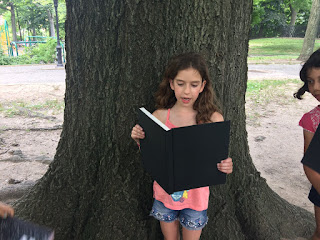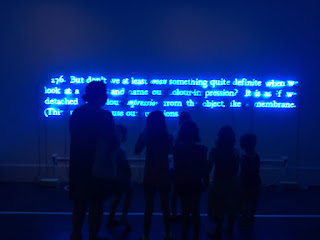Today marked the half-way point of our program, and even after two days of near-constant writing, when it came to energy levels, the kiddos did not disappoint. We started the day off with an attempt at playing some mix of hide-and-seek and "explorer," with ours kiddos each coming across a large stick that they planned to use as a tool for adventuring. But as we set off on a walking trail, the kids almost immediately came across the delicate body of a fallen woodpecker. The image was a beautiful and also sad one, and the kids took note almost immediately as they gathered around the dead bird with a mix of curiosity and wonder.
Annabel suggested that we hold a funeral for the bird, which the other kiddos immediately took to, which meant that hide-and-seek was off and that we had a ceremony to plan. The kids scattered around to assemble bouquets of leaves and flowers (we made a one-time exception regarding our "no picking flowers" rule, but asked the kids the exercise some real judgement when plucking valuable plants out from the ground). Once the gifts had been assembled, we all gathered around the bird and gave short speeches, thanking the bird for everything from being pretty to "helping make other woodpeckers in the park." One by one, the kids went in a circle, said their peace and placed their gifts around the tiny woodpeckers body, and ended the ceremony with a rousing rendition of "Amazing Grace" lead by Romy, with accompanying hums by the youngsters.
We then marched forth to Mount Prospect Park, back to the gorgeous patch of green we had spent most of Tuesday in. Once there, we laid out our trusty tapestry, grabbed our notebooks and got down to what was definitely our most challenging lesson yet! We decided it was time to get our kiddos' hands dirty with the messy form of Enjambment. In order to explain what the form was, we started by explaining the French roots of the word, with some much-appreciated guidance from our PS 133 French speakers. Once we nailed down how to say the word (that tricky, tricky silent "b" doesn't help), we began to explain just what exactly this pillar of poetry is.
Earlier in the week, we explained the difference between a sentence and a line in poetry. A sentence is a set of words that are complete and cohesive, often using grammar as a way to differentiate certain intentions or details. As line, on the other hand, is the way in which a poem's structure is divided, which often means it interrupts a sentence. For instance, a sentence can never just be one word; a line can! Often, a poem can stretch across an entire page, but upon closer inspection might just be a single sentence. Lines break that sentence up without ending them. This critical component of a poem—in which a sentence continues across multiple lines—is called Enjambment.
We asked our daring our young writers to go one step further and consider the specific elements of each line. We taught them that the word a line ends on is extremely important, and worthy of deliberate examination. Within the context of a sentence, it may just be one word among many—but with the use of enjambment, the last word of a line is like an image you are momentarily leaving your reader with. Each line is an active pause in the sentence (if the poem contains punctuation at all), which makes the word you end with extremely important; it hangs in the air while you're taking that breath between lines. As a result, we encouraged our kids to try to avoid ending lines with words that may lack power, such as "and", "the" and "a". This lead to a broader conversation about the power that a single word holds, and how certain words gain more power when used, while others lose their power when uttered too freely (this lead to our unofficial banning of the word "awesome"—less a rule and more of a light recommendation). We spoke briefly about things that are awesome and broke down the word. The kids agreed a backpack is not awesome (maybe "cool"), but a book or an experience can (not always, of course) warrant the magnitude of that word.
In an effort to create a structure that would better explain enjambment, we fused the lesson with a form known as "acrostic poems". Acrostic poems are a form in which a word is written vertically along a page, with each letter serving as the start of a sentence.
Here's a less-than stellar example:
E veryone loves to read.
L ucy kicked the ball.
M any people hate the beach.
Instead of having our kids do acrostic poems with end-stops (grammar or punctuation at the end of a line), we asked them to incorporate enjambment by having the line continue onto the next, using the following line's letter as the start of the next word. After two days of awe-inspiring poetry (we are trying to drop the word "awesome" from our vocabulary as well), we knew that even though this assignment was challenging, our fearless poets would be more than up to the task.
And girl were we right. As a framework, we had them use the name of a very important friend of Romy's for their acrostic poem: Reed. Reed is a member of Act Up New York and the Director of Policy for Housing Works, and earlier this week was arrested by the police after he and fellow protestors demonstrated against the Republican Health Care Bill on the Senate and House office buildings. According to Time Magazine, "demonstrators who refused to stop protesting were arrested and charged with 'crowding, obstructing, or incommoding'..."
 |
| Reed and his friends/ fellow activists chanted, "Health care is a human right! That is why we fight fight fight!" | photo by Naina Devi |
 | |||||||||
| For Mike, on the occasion of his birthday! | - Love, Sylvia |
by Sylvia


by Lyla


by Amelia
by Annabel
by Wynnie
There's even a chance that Reed, his wife, Anna, and his nine-month old baby Mila, will attend the reading at Unnameable Books on July 21, which the kids were overjoyed to hear!
After sharing the poems, we took a lunch break and then headed straight over to the Brooklyn Museum to visit the Infinite Blue exhibit, which culls together a variety of pieces from the museum's permanent collection, all of which prominently feature the color blue. The exhibit investigates the presence of the color throughout the centuries and across multiple mediums. Though we originally intended to pair our visit with Maggie Nelson's Bluets, a book of prose poems dedicated to the color blue, we realized that after a day spent breaking down such complex ideas and discussing some real heavy subject matter, Infinite Blue was best experienced by itself—an artistic celebration of the same subject, but through a totally different framework.
Instead, we found poetry within the museum walls: Joseph Kosuth's neon rumination on the color's "elusive relationship between words, things, and their visual representation"; Hito Steyerl's video essay, framing blue as the connection between all things natural, physical and digital. The day's writing exercise proved to be a bit too challenging for our brave little poet, Ubalo, so instead we ventured with him solo and worked on finding out his thoughts on the color blue. True to form, he didn't disappoint:
The blue is like escaping.
The blue is like taking over all the parts of an alligator.
The introductory essay accompanying Infinite Blue lays the groundwork for what exactly makes the color such a point of fascination for centuries worth of artists: "Blue is often associated with the spiritual, since blue is the color of the heavens." Reading this took us back to the start of our day, when hours before we stood in silence and honored a fallen woodpecker, thanking it for its service and bidding its spirit adieu. It was a powerful way to close out the day, celebrating a color we see every time we look up.
Feeling blue in a good way,
Rod & Romy
































No comments:
Post a Comment